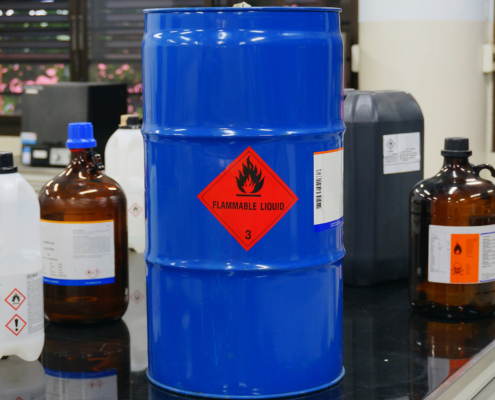
What Is Polypropylene?
Do you know why polypropylene is such a widely used material? It is an important material used in a variety of different applications, including consumer products, automotive parts, and even textiles. First produced in 1951, PP has since exploded in popularity, and is now used in a wide range of commercial and industrial settings.
But what is it about PP that makes it so special? And what are the best ways to use it?
An Intro to Polypropylene
Technically speaking, polypropylene is considered a thermoplastic, and it’s also considered an addition polymer, since it’s made by combining different propylene monomers. Currently, the world generates about 45 million metric tons of polypropylene every year, and demand for the product is estimated to rise consistently over the next several years.
It is most popularly used in the packaging industry, as the packaging industry uses approximately 30% of all the PP in the world. Household appliances are responsible for consuming 10%, and automotive industries consume another 10%.
There are several features of polypropylene that make it ideal for a wide range of applications. For example, this material has a relatively low density when compared to other plastics, enabling it to minimize the weight of a specific part or appliance. Polypropylene is also relatively easy to manufacture, making it inexpensive for what it does.
One of the most important characteristics of polypropylene is its resistance to organic solvents at room temperature, and it does not break even when repeatedly bent or distorted. Many industries also appreciate the copolymerization potential of this material, allowing it to be combined with other plastics and polymers to create hybrid materials.
You might already be familiar with polypropylene in its use in dishwasher safe plates, toys, or household appliances.
Polypropylene Material Characteristics
These are the characteristics of polypropylene that make it such a useful material in manufacturing and in some specific applications:
Resistance to Chemical Reactions
As long as they’re diluted, bases and acids don’t strongly react with polypropylene, making it an excellent choice for containing certain types of liquids, such as cleaning agents, chemicals, and first aid products. If you use a material that isn’t capable of resisting chemical reactions like this, the container could be destroyed the moment you attempt to fill it up with a specific substance.
Toughness
Despite the material’s elasticity, it also has a certain amount of toughness. One of the downsides of elasticity is that elastic materials can quickly bend out of shape if they’re too flexible. But polypropylene overcomes this weakness with its toughness, allowing it to deform plastically without breaking.
Elasticity
Like many other plastics, propylene is relatively elastic, allowing it to be manufactured and reshaped easily.
Electrical Insulation
PP is sometimes used in electronic components because of its high resistance to electricity.
Resistance to Fatigue
Certain materials can become fatigued over time. They can lose their shape as they experience torsion, flexing, and bending. This isn’t the case for polypropylene, as it has significant fatigue resistance. Because of this, polypropylene is frequently used to make living hinges.
Low Friction
Polypropylene has a somewhat slippery surface, making it potentially useful in low friction applications. For example, it’s sometimes used as a contact point for furniture, making it easy to slide on floors, and as well as gears.
Translucence
In normal manufacturing processes, polypropylene is naturally opaque. However, it can also be made to be translucent or even completely transparent. No matter how much light you want to pass through this material, you can create a propylene material perfectly suited for the application.
Why Are Polypropylene Measuring Containers Useful?
Why is polypropylene such a useful material for chemical measuring containers? Polypropylene introduces several advantages that other materials just don’t have:
Resistance to Chemical Reactions
Remember that PP is highly resistant to chemical reactions. That doesn’t mean that chemical reactions are impossible, but most of the chemicals you transfer shouldn’t directly or violently interact with the polypropylene.
High Heat Tolerance
The melting point of PP is 160 degrees Celsius. The high heat tolerance of this material makes it capable of storing very hot substances.
Affordability
Despite all these other advantages, polypropylene remains relatively inexpensive to manufacture.
Toughness and Durability
People also love the high toughness and durability provided by polypropylene. This material is designed to endure pressure, torsion, and bending without losing its shape or deteriorating over time. In other words, your measuring containers will be very tough and capable of performing well for many years.
Transparency and Translucency
One significant bonus of using polypropylene is that you can manufacture it to be as transparent or as translucent as you want it to be. Because it can be made totally clear, it’s an excellent choice of material for measuring containers.
Looking for chemical measuring containers?
Is Polypropylene Safe?
Polypropylene is generally considered safe for use. However, there are some chemicals found in a variety of different plastic products that contribute to cancer risk. Accordingly, you should exercise caution when working with polypropylene materials on the regular. You need to be especially cautious when repeatedly using PP materials to store and eat food.
You should also avoid inhaling fumes from plastic containers, ingesting polypropylene, chewing on polypropylene, or touching polypropylene directly for long periods of time; this is because all of these activities can lead to your body’s absorption of phthalates, potentially dangerous chemicals used to soften plastics.
If you’re using polypropylene measuring containers, you should also take precautions to protect yourself against the chemicals you’re storing or transferring using these containers. That typically means wearing personal protective equipment, such as goggles, heavy duty aprons, gloves, and appropriate footwear.
That said, polypropylene is one of the safest materials we have for storing and working with certain types of chemicals. It remains one of the most reliable, inexpensive, and functional materials in these industrial applications.
Chemical measuring containers are indispensable for your business.






